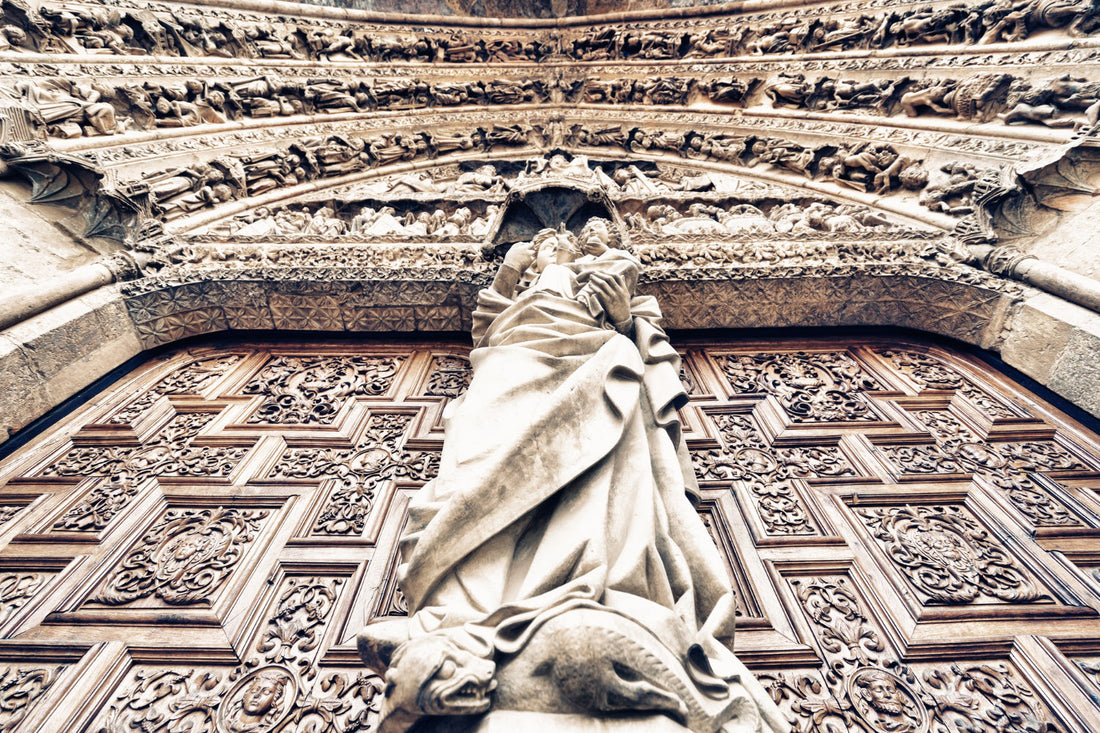Sacred art holds a unique place in spiritual and cultural heritage, bridging the earthly and the divine. These treasured works embody beauty, truth, and the spiritual aspirations of a community, enhancing worship and connecting generations. Proper care and maintenance are essential to preserving their artistic and spiritual significance
Let’s Get Straight to the Point
Sacred art is more than decorative; it is vital to faith, culture, and history. Caring for sacred art involves assessing its condition, using appropriate restoration techniques, and maintaining a stable environment. Preservation efforts protect the physical integrity of these pieces and ensure they continue to inspire worship and cultural appreciation for generations to come.
Understanding the Significance of Sacred Art in the Catholic Church
Sacred art is an invaluable Catholic Church element woven into its spiritual practices, cultural heritage, and educational mission. For centuries, it has visually represented the Church’s teachings, offering believers a way to connect with the divine.
Beyond its aesthetic appeal, sacred art serves essential purposes: enriching worship, preserving theological truths, and fostering communal unity.
1. Enriching Worship and Prayer
Sacred art transforms ordinary spaces into sanctuaries of divine encounter.
- A Pathway to the Divine – Visual representations of Christ, saints, angels, and biblical scenes guide believers into deeper contemplation of divine mysteries.
- Facilitating Prayer – Depictions of the Holy Spirit, the Virgin Mary, and sacred figures provide a focal point for meditation, helping individuals enter a state of reflective prayer and connection to God.
- Enhancing the Liturgical Experience – Sacred art complements hymns, scripture readings, and sacraments, setting a reverent atmosphere for worship.
Example: A mural of the Last Supper in a church can invite worshippers to reflect on the significance of the Eucharist, deepening their participation in Mass.
2. The Role of Beauty in Sacred Art
Sacred art embodies divine beauty, designed to uplift and guide the human spirit toward God.
- A Reflection of God’s Creation – The Church teaches that beauty reflects God’s goodness and truth. Sacred art captures this belief through masterful craftsmanship and harmonious design.
- Inspiring Wonder and Awe – The aesthetic qualities of sacred art evoke emotions that encourage believers to marvel at the greatness of God.
- Evangelisation Through Beauty – The universal appeal of beauty allows sacred art to transcend language and cultural barriers, making it an effective tool for spreading the Gospel.
Example: Michelangelo’s Sistine Chapel ceiling captures the creation story with breathtaking artistry, inspiring awe in all who admire it.
3. Preserving Theological and Cultural Traditions

Sacred art is a vital link to the Church’s history and a medium for transmitting its teachings.
- Teaching Through Imagery – Before widespread literacy, sacred art was a primary means of communicating the Word of God. Paintings, sculptures, and stained-glass windows depicted biblical stories, helping believers internalise scripture.
- A Record of Faith – Sacred art preserves the Church’s heritage, offering insights into its historical and theological developments.
- Connecting Generations – These artworks link modern believers to the faith of their ancestors, ensuring the Church’s timeless truths remain relevant.
Example: The Ajanta Caves in India, adorned with early Buddhist paintings and parallel Catholic sacred art, demonstrate how visual storytelling has been a global tradition for conveying spiritual truths.
4. A Unifying Force for Community
Sacred art brings people together through shared experiences of faith and beauty.
- A Communal Treasure – Sacred art is a focal point for worship, uniting people in admiration and reflection.
- Cultural Identity – Churches and cathedrals adorned with sacred art become landmarks representing the community’s spiritual and artistic heritage.
- Promoting Harmony – The values expressed in sacred art—faith, hope, and love—encourage unity and understanding within diverse societies.
Example: A locally crafted crucifix in a small parish becomes a source of pride and unity, symbolising shared devotion and cultural identity.
5. Sacred Art as a Personal Spiritual Tool
Beyond public spaces, sacred art profoundly influences personal and family devotion.
- Icons and Devotional Art – Paintings, statues, and prints of sacred figures are often displayed in homes, serving as daily reminders of faith.
- A Source of Comfort – Sacred art provides solace during difficult times, reminding individuals of God’s presence and love.
- Inspiring Reflection – Engaging with sacred art encourages introspection and a deeper connection to spiritual truths.
Example: A family displaying an image of the Holy Family may find inspiration for unity and love in their daily interactions.
6. Sacred Art in the Broader Cultural Context
Beyond its role in worship, sacred art enriches humanity’s cultural and artistic heritage.
- A Testament to Human Creativity – Sacred art showcases the skill and dedication of artisans who have contributed to the Church’s mission, reflecting human ingenuity inspired by faith.
- An Educational Resource – Museums and exhibitions featuring sacred art allow people from all backgrounds to appreciate its historical and spiritual significance.
- Bridging Faith and Society – Sacred art fosters dialogue and understanding across cultures by expressing universal values like truth and beauty.
Example: The Vatican Museums attract millions of visitors annually, offering them a chance to engage with sacred art in the context of world history.
How to Assess and Prepare for Restoration
Assessing and preparing sacred art for restoration is the first step in ensuring its longevity and spiritual impact.
1. Condition Assessment
- Evaluate the physical state of the artwork, noting any damage, discolouration, or environmental impact.
- To tailor the restoration approach, identify the medium, whether a painting, sculpture, or drawing.
2. Consulting Experts
- Engage restoration specialists to determine the best methods for preserving the work’s aesthetic and historical value.
- Understanding the piece's context ensures its restoration aligns with the artist’s original intent.
3. Restoration Planning
- Develop a detailed plan, including the required materials and methods, to maintain harmony between the past and the present.
- Address environmental factors that may contribute to further damage.
Restoration Techniques for Religious Art
Proper restoration techniques honour sacred art's spiritual and artistic essence while using high-quality art, ensuring its durability.
1. Repair and Stabilisation
- Use methods like stabilising delaminated paint or cleaning to remove residues that obscure the artwork’s details.
- Preventative measures ensure that fragile areas are supported and reinforced.
2. Inpainting and Cleaning
- Inpainting subtly restores damaged areas without altering the original composition.
- Cleaning techniques remove dirt and stains while protecting the artist’s intent and materials.
3. Avoiding Overpainting
- Overpainting can obscure the work’s original details and disrupt its spiritual impact.
- Restoration should prioritise preserving the truth and beauty of the original piece.
Preserving Artistic Heritage for Future Generations
Ensuring the longevity of sacred art requires proactive care and respect for its spiritual and cultural significance.
1. Environmental Control
- Avoid exposure to direct sunlight, which can fade colours and degrade materials.
- Maintain stable temperature and humidity levels to prevent cracking, warping, or mould growth.
2. Careful Handling and Display
- Use proper techniques when moving or mounting artwork to avoid accidental damage.
- Display pieces in secure, stable locations that protect them from potential harm.
3. Passing on the Legacy
- Sacred art often becomes part of a family’s heritage, carrying deep spiritual and personal meaning.
- Sharing its story and significance ensures it remains a cherished part of family and community life.
Conclusion
Sacred art is a timeless treasure that embodies the intersection of faith, beauty, and history. By understanding its significance, using proper restoration techniques, and creating environments conducive to its preservation, we ensure that these works continue to inspire and uplift future generations.
Caring for sacred art is about maintaining its physical form and honouring its spiritual essence and role in connecting us to the divine and the community.
FAQs
1. How can I preserve sacred art at home?
Keep it away from direct sunlight, maintain consistent humidity levels, and frame it with protective materials to prevent environmental damage.
2. What are the most important parts of common restoration techniques for sacred art?
Restoration techniques include inpainting to repair subtle damage, stabilisation of weakened surfaces, and cleaning to remove residues while preserving original details.
3. Why is sacred art significant in the Catholic Church?
Sacred art enhances worship by visually expressing spiritual truths, deepening prayer, and serving as a testament to faith and cultural heritage.
4. How do environmental factors affect sacred art?
Fluctuations in temperature and humidity, exposure to sunlight, and pollutants can degrade materials, causing fading, cracking, or warping of original art.
5. Why is it important to support sacred art and its preservation?
Supporting sacred art ensures its historic role in worship and culture continues while protecting its historical and spiritual legacy for future generations.

